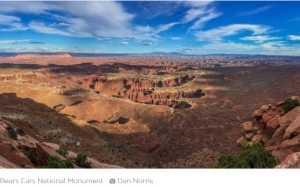Bears Ears Makes History with Release of Proposed Management Plan in Collaboration with Five Tribes
NPCA News Release
This plan marks historic progress, incorporating Tribal collaboration into the care and stewardship of this critical landscape“–Theresa Pierno, NPCA’s President and CEO
The Valley of the Gods region in Bears Ears National Monument. According to the Bears Ears Inter-Tribal Coalition, the landscape at this national monument is known to contain more than 100,000 sites of cultural and archaeological significance.
WASHINGTON, DC – The Biden administration in collaboration with five Native American Tribes proposed a first-of-its-kind resource management plan for Bears Ears National Monument in Utah that incorporates Traditional Ecological and Indigenous Knowledge.
 © Arlene Hochman Waller/Dreamstime
© Arlene Hochman Waller/Dreamstime
The plan aims to manage the lands and resources of Bears Ears in collaboration with Tribes, to fulfill the vision of President Obama’s proclamation that established the monument and President Biden’s proclamation that restored its boundaries.
The proposed resource management plan will guide resource policies and procedures for the monument’s 1.36 million acres of public lands. It is the result of a multi-year collaboration with the Bears Ears Commission – the Ute Indian Tribe, Ute Mountain Ute Tribe, Zuni Tribe, Hopi Tribe and the Navajo Nation – and federal partners at the Bureau of Land Management and the U.S. Forest Service.
NPCA is carefully reviewing the final plan which is expected to shape policies that protect Bears Ears National Monument for years to come and help connect one of America’s most diverse national park landscapes from Glen Canyon to Canyonlands National Park.
Statement by Theresa Pierno, President and CEO for the National Parks Conservation Association (NPCA):
“Since time immemorial, Bear Ears has been a place of healing and refuge, connecting many Tribal communities to their ancestors across centuries. By placing Tribal collaboration at the forefront, we all benefit along with our national parks and public lands.
“Years of determination and hard work by Tribal Nations, local communities, businesses, and people across the country have led to this moment. This plan marks historic progress, incorporating Tribal collaboration into the care and stewardship of this critical landscape.
“This would not have been possible without the unwavering leadership of the Ute Indian, Ute Mountain Ute, Zuni, and Hopi Tribes and the Navajo Nation. NPCA is proud to have worked alongside the Tribes, whose leadership reinforces the integral role of Traditional Ecological and Indigenous Knowledge in shaping the future of our public lands.”
Malcolm R. Campbell is a long-time member of NPCA.



